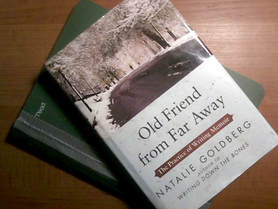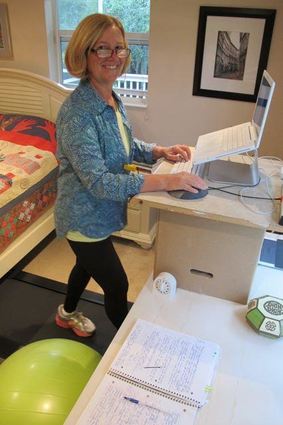|
By Graham Strong  I took a creative writing class in university, and the second-most important lesson I learned was the power of trying new writing approaches to unlock creativity. Our assignment was to write a poem in the style of e.e. cummings. It was the magician’s classic trick of misdirection – we were so busy trying to write in his distinctive way that we didn’t notice our own creativity at work. Even though I’m not exactly a poet, the highest mark I received in the course was for that assignment. Why did it work? It’s simple: it helped the writers in the class get out of our ruts. Ruts are a natural thing. Humans are designed to learn pathways to success by exploring what works and bumping into what doesn’t – and then following those pathways to success over and over again. But as useful as that is for a species, it’s deadly to creativity. Here’s a secret: that well-worn, rutted path is just one way to the finish line. There are other successful paths yet to be found. As creatives, we need something to knock us out of our cow cart path and find new – and more interesting – directions. Flash fiction can help us jump the tracks. It is a chance to experiment and grow as writers, no matter what type of writing you normally do. The format is compressed enough that you really have to focus on telling the story in a short amount of space. That in itself forces you to be creative. It also makes you think about different ways of getting your story across to your reader because of the strict confines of the writing form. Challenge yourself as a writer by giving flash fiction a whirl. Then enter your best story in our summer Flash Fiction contest for a chance to win cash prizes. [Link: http://www.nowwwriters.ca/noww-blog/noww-flash-fiction-contest] You’ll find yourself exploring new fields in no time! (PS – the most important lesson I learned, in case you were wondering, was how to take criticism. Very important for a writer!) Some Writing Prompts to Get You Started Stuck on what to write about? It’s a common affliction – so common in fact that there are dozens of websites out there to help you out with writing prompts and story ideas. Here are a few writing prompts to rev up your imagination: staircase Sleeping Giant pancakes forklift iceberg Nothing tickle your fancy? Check out: http://writingexercises.co.uk/random-words-exercises.php for a nifty little program that generates eight one-word prompts at a time.  Graham is a full-time freelance marketing writer, journalist, and ghostwriter and has been a writer his entire life. Graham is a former Editor-in-Chief of Argus, the Student Newspaper of Lakehead University, and helped transition it into one of the first digitally produced newspapers in North America. Graham won an Honourable Mention in NOWW’s first writing contest in 1998 for his short story Hat Trick. Professionally, Graham provides marketing writing services to businesses and organizations around the world. He also writes for several news outlets including the Sudbury Mining Solutions Journal and the Northern Ontario Medical Journal, and has written for Canadian Press. In his spare time he is writing his first novel. Graham lives in Thunder Bay with local potter Noël Keag and their three incredible sons. His favourite writers are Paul Quarrington, F. Scott Fitzgerald, and Hunter S. Thompson.
0 Comments
by Sue Blott (This blog was originally posted on 2/28/16)  I recall a jump rope chant. I’m six again in the alley beside my house, rope slapping against cobblestones; my red leather shoes with perforated edges tapping the slippery stones; the stones themselves, steely blue grey at their best like ice cubes from a North Sea storm. Aloud I chant as I skip: Sausage in the pan sausage in the pan sizzly sizzly sizzly sausage in the pan Something spectacular happens at the ‘sizzly sizzly’ part, something which sets this verse apart from the other verses of the chant. Perhaps a sideways jump, feet to the left, feet to the right, to emulate the zeds in sizzle. I forget. No matter. The memory is what counts...a memory captured by this book, Old Friend From Far Away The Practice of Writing Memoir by Natalie Goldberg. The memory is as rich as the rhyme itself, unearthing sounds and smells and the rhythm of life. I’m glad to have recovered it because it can take me places in my writing, any form of writing, not necessarily only creative non-fiction. Such is the beauty of Goldberg’s book—her explanations and exercises act like fish hooks snagging unsuspecting memories and dragging them to the surface. I bought the book last fall at Banyen Books in Vancouver along with some Tibetan hand-rolled incense and a deep red glass heart. Before I had finished the book’s introduction (entitled “Read This Introduction”) I knew it would fast become another writing book staple. I read it as a bedtime book first, anxious to bask in her words, skipping from mood to mood, exercise to exercise, perhaps cautious of murky memories. If I merely read the book instead of working through it, all those circling shark-like feelings would remain below the calm surface of my consciousness, right? Not so! Several times after I put the book down and began to drift to sleep, a fresh insistent memory or a powerful emotion stirred by the book made me drag myself back from sleep to quickly write it down and snatch its essence. Not necessarily a relaxing bedtime read! Imagine the magic of working through the book, committing to her exercises, absorbing her words. Already I have several poems inspired by a simple read through. Old Friend from Far Away is divided into ten sections. Each section contains an eclectic mixture of short explanations or anecdotes, often from Goldberg’s own life, and exercises. Dip into any section, let her words ignite: “Writing has to move us. Writing is alive, a living process...Whatever is hidden or secretive will look for a way out. You’ll write about a grilled cheese sandwich and bubbling up in the middle of the cheese will be incest, deception, and adultery.” Do any exercise, prepare for surprise: “When did you pretend not to care? Go. Ten minutes.” “Write a last letter to someone...Allow truth, like an open bowl—don’t try to put a lid on it or a bow.” Natalie Goldberg’s first writing book, Writing Down the Bones, is one of my all time favourites, one I refer back to time and time again, one I regularly recommend to other writers. Old Friend from Far Away is now another steadfast favourite. As I read it, I find one hand turning the skipping rope all those years ago and the other hand holding a pen: Pen across the page pen across the page sizzly sizzly sizzly sizzly pen across the page Something spectacular has happened. I’ve touched the raw nerve of an old memory and ignited it, if only for a book review. But don’t just take my word for it. Read the book and, in Goldberg’s own words, “...let’s pick up the pen, and kick some ass.” Go. I double dog dare you! By Dorothea Belanger This blog was originally posted on January 24, 2016.  The old treadmill has been replaced with the more portable LifeSpan Desktop treadmill. I have intentions to replace the flow form counter top/ cardboard box combination, but it does the job! The old treadmill has been replaced with the more portable LifeSpan Desktop treadmill. I have intentions to replace the flow form counter top/ cardboard box combination, but it does the job! Psst, have you heard? Sitting is the new smoking and it’s killing us! Studies show that sitting a mere three hours a day shortens life expectancy. Then there’s the chronic injury and pain degrading that quality of life. I experienced this first hand when I cut back teaching to two days a week to write a novel, [no pressure there, ha]! White Flowers was inspired by stories about the 400 German Prisoners of WWII who’d been interned on Lake of the Woods and a trip I took to visit cousins in Berlin. In my 40s, I started having brief bouts of back pain. A physio diagnosed unstable ribs, taped them in place every now and again and told me to remain active. I carried on fine with my full life: family, work, writing, yoga, swimming and walking. As I began to write more, I knew that sitting in front of a computer didn’t feel good so I invested in a highly rated office chair. The accompanying DVD illustrated how to adjust the arm rests, the lumbar and the seat pan to support me. I was sure this chair could launch me into the galaxy of novel writing for many pain-free hours! Unfortunately it was all for naught. One day I leaned forward to get out of the car and blew a few discs. I spent the next few months lying on the living room floor in pain. When I became mobile, I was limited and needed carry out at the grocery store, couldn’t put on my socks and was unable to read let alone write. What followed was years of trying different ways to write. Initially, heating pads and lumbar supports on the chair were my best friends and enabled me to put together a grant proposal. I sent a chapter of White Flowers to the Northern Arts division of the OAC and was successful. This bought me more time to write and was an affirming boost. After brief sessions at the computer, I’d continue working by walking and talking into a hand held tape recorder. In this way I modified an excerpt of White Flowers for The Writers Union of Canada Short Prose contest and made the short list! Icy roads made walking in the winter treacherous so my husband rigged up an old treadmill to fit under a table. I could walk at a slow speed and type or write with a pen but not for hours. I set a kitchen timer and alternated between the chair and the treadmill every 30 minutes. But I was still fragile and watching out for what might set me back was utterly consuming. Riding my bike over a little bump the next summer caused my spine to lock up and I walked around like the Tin Man for a week. Someone suggest a chiropractor. I don’t understand how the cracking of my neck, mid back and and sacrum works but this weekly 10 minute treatment was a turning point. Between cracks she explained that given the right cues, your body will heal. The following week I told her swimming, my old standby for staying in shape, was causing arm pain. She told me to try a mask and snorkel to keep the neck neutral. Body in neutral, three natural curves in the spine. I’d heard that often in yoga classes and decided to take it seriously. I placed a full length mirror against the wall to check how I was sitting in the chair. I looked a bit hunched, I certainly felt sluggish. I tried a stability ball and on it I could sit taller, there were three curves in the spine and I felt perkier! By alternating between the ball and the treadmill every 30 minutes, I could write for two energy-filled hours a day. Charles Wilkins presented a writing workshop at the Word on the Water Writing Festival in Kenora. Not only had he rowed across the Atlantic, he’d taken notes and written a book about it! I was in awe of that physical feat and inspired by his thoughts on a sense of place in writing. To test them out I wrote an article about how stories can deepen a connection to place which was published in Canada’s History. I decided to put White Flowers on hold in favour of shorter articles. I needed to have a sense of completion. Figuring out how to chop carrots and vacuum with out seizing up was too consuming alongside the scope of novel writing. [Now I can chop carrots indefinitely at the kitchen table, it’s lower than the counter. Vacuuming is still iffy so I break it up over several days or let the house get dusty.] I’d been a member of NOWW for many years. I enjoyed the writing by others who shared the same geography of northwestern Ontario in the NOWW HEAR THIS magazine. Meeting them at workshops in both Kenora and Dryden was like an invigorating transfusion of fresh ideas to take back to my own writing. I attended the Sleeping Giant Writers Festival in Thunder Bay. While reading a new excerpt of White Flowers out loud in Miriam Toew’s master class, I immediately sensed how it fell flat. Miriam made polite suggestions but at lunch I got the best feedback from another participant: try putting the scene in the present tense, to make it more immediate. I met Miriam in the hallway that evening and babbled on about the difficulty of making historical material come alive. She listened, paused and said: just think really hard. I drove back home fired up for another year of writing. Now I allow time for “just thinking really hard” while writing, after all, it’s what I did to heal and strengthen. And when I read, I ask myself, how is the writer making this scene more immediate? These tips mentioned in passing have pushed me forward to better writing. I can’t emphasize enough how instructive it is to belong to a community of writers. The only time I use my office chair now is for the monthly NOWW board meetings I attend via Skype. I don’t want all the movement on the ball or the treadmill to draw attention and after all these years, I can sit there once a month without atrophying, it’s no problem! |
NOWW Writers
Welcome to our NOWW Blog, made up of a collection of stories, reviews and articles written by our NOWW Members. |
Proudly powered by Weebly

 RSS Feed
RSS Feed